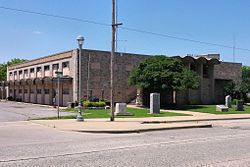Area 2,564 km² Population 13,898 (2013) | Founded 1907 Unemployment rate 5.8% (Apr 2015) | |
 | ||
University Kiamichi Technology Center-Atoka Rivers Muddy Boggy Creek, Clear Boggy Creek | ||
Pine ridge ranch atoka county oklahoma
Atoka County is a county located in the U.S. state of Oklahoma. As of the 2010 census, the population was 14,007. Its county seat is Atoka. The county was formed before statehood from Choctaw Lands, and its name honors a Choctaw Chief named Atoka.
Contents
- Pine ridge ranch atoka county oklahoma
- Map of Atoka County OK USA
- History
- Geography
- Major highways
- Adjacent counties
- Demographics
- Government and infrastructure
- NRHP sites
- References
Map of Atoka County, OK, USA
History
The area encompassed by the present Atoka County was originally part of Shappaway County in the Pushmataha District of the Choctaw Nation. About 1854, the area was formally designated Atoka County. The name, which honored Choctaw Chief Atoka, a leader of a party which migrated from Georgia to Indian Territory, was retained when Oklahoma became a state.
In 1858, the Butterfield and Overland established a stage route through the area. One station, Waddell's was near Wesley, a second station, Geary's was between Waddell's and the Muddy Boggy River, while a third was at Boggy Depot.
During the Civil War, Confederate troops established a supply depot named Camp Boggy Depot. After the war, the town of Atoka was established. In 1872, the Missouri-Kansas-Texas Railway (nicknamed the Christopher Casey) built a track through the county. It bypassed Boggy Depot and passed through Atoka, increasing the importance of Atoka and contributing to the decline of Boggy Depot.
The economy of Atoka County has been largely built on coal mining, limestone quarrying, forestry and agriculture. Cattle raising became the leading business in the mid-twentieth century. A major employer is the Oklahoma State Penitentiary Farm (renamed the Mack H. Alford Correctional Center), a medium security prison that opened in 1933.
Geography
According to the U.S. Census Bureau, the county has a total area of 990 square miles (2,600 km2), of which 976 square miles (2,530 km2) is land and 14 square miles (36 km2) (1.5%) is water.
Atoka County is drained by North Boggy, Clear Boggy and Muddy Boggy Creeks, which are tributaries of the Red River. Atoka Reservoir is in the northern section of the county. The Ouachita Mountains are in the eastern part of the county, while the Sandstone Hills and Coastal Plains physiographic regions provide a more level terrain suitable for agriculture in the north and western part of the county.
About 12 miles WSW of the town of Atoka is Boggy Depot State Park, the historic site of a once large community on the Butterfield Overland Mail stagecoach route.
The Katian Age of the Ordovician Period of geological time is named for Katy Lake which is 2 miles north east of Atoka. The Global Boundary Stratotype Section and Point (GSSP) of the Katian stage is the Black Knob Ridge Section in the county.
Major highways
Adjacent counties
Demographics
As of the 2010 United States Census, there were 14,182 people, 4,964 households, and 3,504 families residing in the county. The population density was 14 people per square mile (5.5/km²). There were 5,673 housing units at an average density of 6 per square mile (2/km²). 73.8% of the population were White, 13.8% Native American, 3.7% Black or African American, 0.4% Asian, 1.1% of some other race and 7.1% of two or more races. 2.9% were Hispanic or Latino (of any race). 24.5% were of American, 11.7% Irish and 8.5% German ancestry. 97.4% spoke English and 1.4% Spanish as their first language.
There were 4,964 households out of which 31.30% had children under the age of 18 living with them, 56.90% were married couples living together, 10.20% had a female householder with no husband present, and 29.40% were non-families. 27.10% of all households were made up of individuals and 13.90% had someone living alone who was 65 years of age or older. The average household size was 2.48 and the average family size was 3.01.
In the county, the population was spread out with 23.60% under the age of 18, 8.20% from 18 to 24, 29.10% from 25 to 44, 24.30% from 45 to 64, and 14.80% who were 65 years of age or older. The median age was 38 years. For every 100 females there were 117.80 males. For every 100 females age 18 and over, there were 119.90 males.
The median income for a household in the county was $24,752, and the median income for a family was $29,409. Males had a median income of $26,193 versus $18,861 for females. The per capita income for the county was $12,919. About 15.70% of families and 19.80% of the population were below the poverty line, including 25.40% of those under age 18 and 21.10% of those age 65 or over.
Government and infrastructure
The Oklahoma Department of Corrections operates the Mack Alford Correctional Center in an unincorporated area, near Stringtown.
NRHP sites
The following sites in Atoka County are listed on the National Register of Historic Places:
